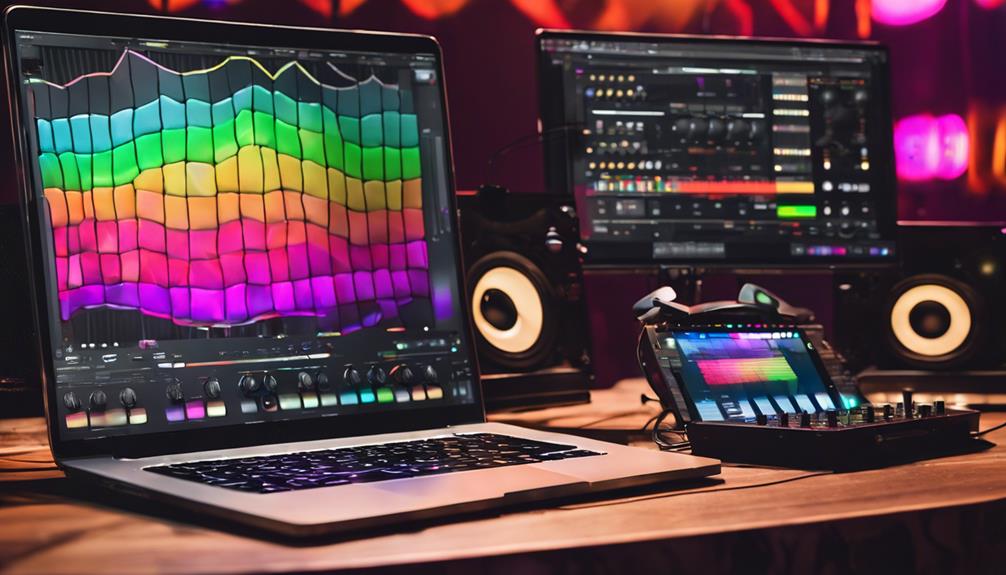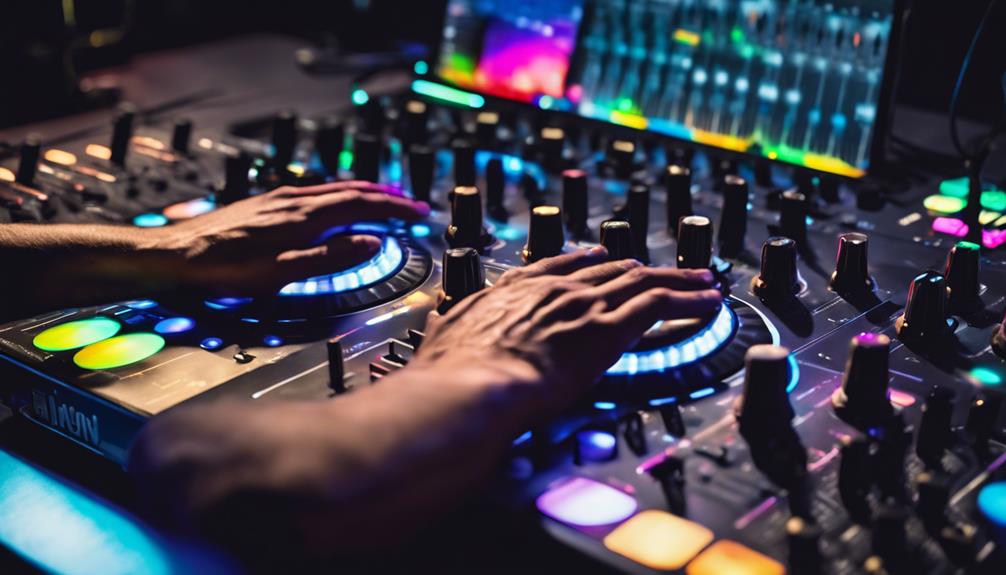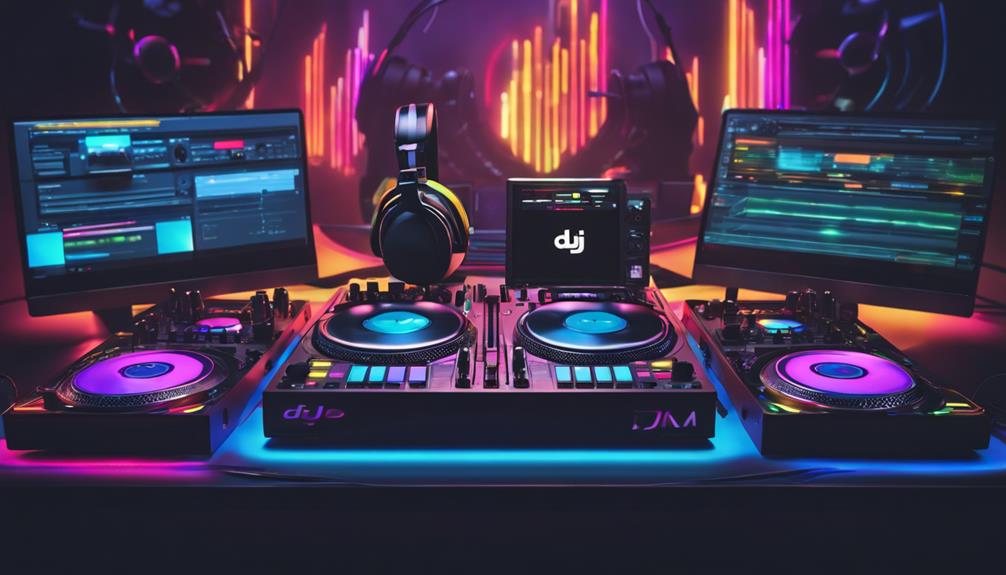No products in the cart.
Switching from vinyl to digital DJing? You’ll need to convert your music library and make sure it’s backed up securely—consider using cloud services like iTunes Match for reliability. Select DJ software compatible with your computer’s specs—high processor power and ample RAM are must-haves. Master digital mixing techniques such as using cue points, syncing beats, and manipulating waveforms to keep your sets dynamic. Don’t shy away from experimenting with real-time effects and advanced features like harmonic mixing to enhance your performances. As you build your setup, invest in a quality sound card and compatible controller. Ready to revolutionize your DJing experience? There’s more to uncover.
Contents
hide
Key Takeaways
- Convert your vinyl music library to digital formats and ensure it’s backed up securely.
- Choose DJ software that matches your laptop’s operating system and hardware capabilities.
- Invest in a high-quality DJ controller or interface for tactile control over your mixes.
- Learn digital mixing techniques, including cue points, looping, and waveform manipulation.
- Experiment with advanced features like harmonic mixing and real-time effects to enhance your sets.
Understanding DJ Software Basics
Digital DJ software typically stores your music right on your hard drive, ensuring easy and quick access during your sets. As you explore the digital domain, understanding software compatibility and hardware requirements is essential. Your choice of DJ software should align with your computer’s specifications to avoid latency and guarantee stability. For peak performance, prioritize a high-powered processor, ample RAM, and a robust internal drive.
Workflow optimization is another key aspect you can’t overlook. Efficient track organization saves precious time and keeps you focused on the creative flow of your set. Software like iTunes is instrumental in this regard, providing intuitive interfaces and powerful tools to categorize and manage your tracks effectively. Implement features like ‘Copy files to iTunes Media Folder‘ to centralize your music library, making it more manageable and accessible.
Transitioning Your Music Library
Converting your music library to a digital format is an essential step to harness the full potential of your DJ software. As you shift from vinyl to digital, backing up your collection becomes vital. Consider using services like iTunes Match, which not only store your tracks in the cloud but also guarantee you’ve got a secure backup. This preemptive step guards against data loss during the shift.
When organizing your music, leveraging iTunes is a smart move. Enabling the ‘Copy files to iTunes Media Folder’ option simplifies the backup process further, storing copies of your tracks within the iTunes directory on your internal drive. This location is crucial for quick access and smoother performance with your DJ software.
Moreover, metadata management is a game-changer. Take the time to properly tag your tracks with relevant data such as artist, title, and BPM. This meticulous approach enhances your efficiency when sorting and selecting music during live sets. DJ software typically supports custom crates or playlists, which replicate the organizational style of iTunes, allowing for seamless integration and retrieval.
Mastering Digital Mixing Techniques
To truly excel in your DJ career, you’ll need to master digital mixing techniques, including the strategic use of cue points and loops in your software. Grasping these elements isn’t just about knowing what buttons to press; it’s about understanding how and when to deploy these tools to create seamless shifts that keep the dance floor moving. Cue points allow you to jump to specific parts of a track instantly, essential for maintaining energy in your set. Pair this with loops to extend these moments or build tension before a drop.
Moreover, the sync function can be a lifesaver, especially if you’re moving from vinyl. It helps you match beats between tracks, giving you the freedom to focus more on other aspects of your mix, like waveform manipulation. Learning to read and manipulate waveforms is essential, as it enables you to visually align beats and execute precise mixes.
Don’t shy away from experimenting with real-time effects. These can transform a track, adding your unique spin to a performance. Remember, it’s your creative flair, combined with technical prowess, that will set you apart. Practice diligently, and you’ll not only perform; you’ll captivate.
Exploring Advanced Digital Features
As you progress further in your DJing journey, exploring advanced digital features like harmonic mixing can greatly enhance your sets. Harmonic mixing, where you blend tracks that are in compatible musical keys, creates a smooth, almost imperceptible shift. This is where key detection benefits come into play; most DJ software can automatically identify the key of each song, taking out the guesswork and letting you focus on the creative aspects of your mix.
Let’s dive deeper into looping techniques. Looping allows you to extend a certain part of a track to maintain energy on the dance floor or to give yourself more time to plan your next move. Mastering this can turn a good set into a great one by continuously engaging your audience with fresh sounds.
Don’t forget to play around with the effects and filters. A quick demo of these might include using a high-pass filter to gradually introduce a track or employing a delay effect to create a buildup before a big drop. These tools are essential for adding your unique touch and can dramatically alter the vibe of your performance, keeping your audience hooked from start to finish.
Building Your Digital DJ Setup
Before you start mixing tracks, you’ll need to assemble a robust digital DJ setup that meets all your performance requirements. First off, selecting the right digital DJ software is essential. Make sure it’s fully guaranteed with your operating system and that your laptop meets or exceeds the software’s system requirements. This guarantees smooth, glitch-free performance, which is vital when you’re in the middle of a set.
Next, let’s talk about controller options. Investing in a reliable controller or interface provides hands-on control over your tracks, making your mixes more intuitive and dynamic. Whether you opt for an all-in-one controller or modular setups, make sure there’s seamless equipment compatibility. This integration is crucial to a fluid performance.
Lastly, don’t overlook the importance of a high-quality sound card. Sound card selection can dramatically improve your setup’s audio output, ensuring crisp, clear sound that does justice to your tracks. For those looking to expand, consider integrating additional MIDI controllers or specialized equipment, boosting your setup’s versatility and giving you more creative freedom.
Setting up software correctly from the start saves you time and stress, letting you focus on what you love—spinning tracks and energizing crowds.
Frequently Asked Questions
What Is the Best Way to Convert Vinyl to Digital?
To best convert vinyl to digital, you’ll need high-quality audio interface and recording software. Make sure your hardware is calibrated correctly, and choose software that allows detailed editing to refine your digital files.
Is It Harder to DJ With Vinyl?
Yes, DJing with vinyl is harder because you’ll rely on analog skills like manual beat matching. It demands precision and practice, unlike digital setups that can automate these aspects for you.
Why Don’t DJS Use Vinyl?
You’re avoiding vinyl due to high equipment costs and storage issues. Digital formats offer easier access, seamless mixing, and lighter loads, making them more practical for modern venues and your dynamic DJ lifestyle.
Can You DJ With a Vinyl Player?
Yes, you can DJ with a vinyl player using a turntable setup. Mastering beat matching and pitch control is essential to deliver authentic, engaging mixes that captivate your audience with every spin.
Conclusion
Now that you’ve dived into the digital DJing world, embrace the power at your fingertips. Your music library’s now vast, accessible, and ever-evolving.
Master those mixing techniques; sync beats, loop seamlessly, and overlay effects to create auditory magic. Leverage advanced features like MIDI mapping and harmonic mixing to push boundaries.
Your setup, tailored and tech-forward, is your new stage. Own it, innovate, and let your passion for music shine. Keep spinning, keep exploring, keep wowing the crowd!




